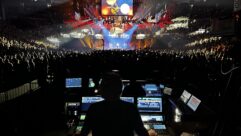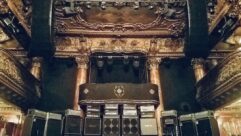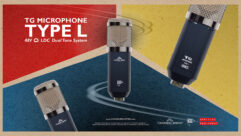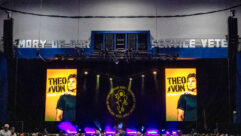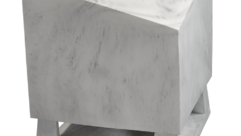Great Platte River Road Archway Monument
Oct 1, 2001 12:00 PM,
By Dennis Earl Moore
WHAT’S THE KEY TO TELLING A FACTUAL, YET EMOTIONALLY RESONANT, story to a museum visitor or tourist at a themed attraction? How do you deliver movie-like intensity without movie-like control, allowing the audience to walk through the facility at their own pace?
That was the challenge which faced Dennis Earl Moore Productions when they undertook the entertainment design of the Great Platte River Road Archway Monument in Kearney, Nebraska. DEMP’s answer was a signature blending of technology and showmanship they term “three-dimensional storytelling.”
Clearly, they have succeeded in their challenge. Open since June 2000, The Great Platte River Road won a THEA Award for Outstanding Achievement from the Themed Entertainment Association in 2001.
Three-dimensional storytelling means using every corner of the facility to deliver the story. Properly applied, it can give a simple walkthrough experience the forward momentum and excitement of a ride and the narrative flow of a movie. Audio and video bring depth, perspective and drama. To achieve success, A/V designers and producers must work hands-on with the entire design team — from initial concept development forward — to seamlessly integrate A/V with physical settings, personal narratives and unifying themes. The goal is to completely and immersively transport the visitor into the themed entertainment world at hand.
THE PIONEERING SPIRIT
DEMP’s client, project developer J. Greg Smith of Omaha, Nebraska, conceived the Archway as a celebration of the American pioneer spirit that sent millions westward. The Archway itself is a massive, 50,000-square-foot, covered-bridge-like building that spans Interstate 80. Inside, the 20,000-square-foot immersive attraction presents the story as an entertaining and educational walkthrough.
The team developed a story of pioneering transportation and communications that spans 150 years of American history, from the wagon train on a dusty path to the cars traversing Interstate 80; from the Pony Express to the Internet; from a roadside tent camp to a classic roadside restaurant.
Millions of motorists pass under the Archway each year. At 11 stories high, with log-cabin-themed buildings anchoring each end, the structure entices many travelers to pull off and check out this impulse attraction. As soon as visitors enter the lobby, they come across another visual hook, calculated to spark their curiosity enough to buy a ticket, and to introduce Archway themes.
JOINING THE WAGON TRAIN
During early design meetings, it was realized that an escalator would be needed to carry visitors from the ground-level entry up to arch level. The entertainment design firm, Dennis Earl Moore Productions, suggested making the escalator part of the story as well, by having it function as a thematic time machine, symbolically transporting visitors to a bygone era. As executed, the escalator design also incorporates one of the first large, permanent high-definition screens in the United States. The 20×27-foot screen sits at the top of the escalator bordered by a period-style gilded frame. On the screen plays a loop-movie of an 1850s wagon train. Ticket buyers ride up the escalator, moving at the same speed as the trundling wagons and slowly rising through realistic rockwork, past detailed cast-figures to join the pioneers. Visitors pass through an opening in the screen and into the past.
Moore’s team faced the technical challenge of producing a movie large and bright enough to read from across the well-lit lobby. The initial spec called for an NTSC image at 6000 lumens, but they felt strongly that only with high-definition imagery could the illusion be maintained as visitors neared the screen. At the time, no adequate, cost-effective high-definition playback system had been perfected, but one was expected within the year. Being on the creative team from the start, DEMP chose to do this project as a design/build. As a result, they were able to postpone the projector decision while shooting the wagon train sequences on super-35mm film.
The shoot was carefully controlled. Lenses and perspective were chosen to match that of the escalator incline. Likewise, the speed of the wagons was set to match the stairs. Rocks and grasses were coordinated with the physical designers and fabricators for a good match. The “live-painting” wagon train had to play continuously to create the mesmerizing effect we wanted. So DEMP devised a hidden loop point by having the first wagon in the train pull directly away from the lens, then used CGI to make the final wagon roll through the camera position, wiping the frame. This allowed the filmmakers to hide the edit back to the first wagon, making a seamless loop.
Part of DEMP’s design/build approach was working with the architects to protect the audio and video system. They were able to keep the ambient light to a manageable level and avoid sight-obstructing beams in the lobby. Because the arch tended to twist in the wind and vibrate from passing tractor-trailers, DEMP designed a huge, floating steel mount to dampen the projector and screen. Imagine a 40-foot oil derrick on its side, hanging like a Calder mobile from two points, with the projector on the small end and the 25×36-foot gold frame and screen on the base.
That’s when technology caught up. Digital Projection introduced its Lightning X Series SX high-definition, 10,000-lumen video projector; and Electrosonic Systems introduced its HD Playback Box. DEMP was then able to deliver pixel-to-pixel 1280×1024 resolution, with no interpolation whatsoever by the projector, at about 7500 lumens. Dimmers were not specified in the set lighting, so an oversized projector, adjustable for lighting conditions and bulb wear, was used — and all within the original budget. The completed lobby uses every element to set up the story. Visitors readily accept the invitation to “slow down, join the parade and become a pioneer.”
TRANSPARENCY
In the themed entertainment business, an A/V designer struggles to become invisible. As in filmmaking, one tries to immerse the audience, while keeping the technology and technique transparent. At the Archway, ambient audio produces realistic surround environments throughout the arch. Personal audio, delivered via headsets, offers intimate first-person commentary and dramatic anecdotes. Sync audio accompanies all video and can be mixed into the other layers. The three systems heard together create an expanded space and keep the narrative moving. It’s the experiential equivalent of a page-turner, moving visitors forward through the story.
Another transparent technique DEMP used is the Drive-In exhibit. The project developer wanted to display factual data on 20th-century transportation. The physical designer wasn’t keen on overloading visitors with text panels, and Dennis Moore opposed the drab monitor-on-a-stick display. So instead, as visitors walk along the 1916 Lincoln Highway set, they can see ahead down the road for another 50 years. The team agreed on a 1950s-style drive-in set piece, easily recognizable even from a distance of 100 feet. By projecting an 8×10-foot movie on the drive-in screen, the set lures visitors onward.
DEMP produced a 6-minute short subject film, featuring a comical but patriotic history of the road, in 1950s newsreel style. As visitors walk up to the Drive-In, they discover that the once-familiar cast aluminum speakers on posts actually work, delivering the soundtrack. (The sound engineer, Brian Phraner, found a supplier still making the authentic replacement speakers!) The Drive-In conveys content so effectively within a fun, crowd-pleasing and culturally authentic setting that visitors are unaware they’re absorbing exposition.
PROTECTING THE STORY
Protecting the story content and value of the media is crucial to three-dimensional storytelling. If a scene lacks anything, it may confuse or turn off visitors and diminish the overall experience. The Buffalo Run offers an example: DEMP designed and shot a high-resolution, rear projection of a stampede on a beautiful grassy prairie. The screen is built into a set, with matching ground forms and grasses, and angled mirrors. Visitors are surrounded in a 270° image of charging buffalo. Lighting blends the foreground with the video.
A cast figure of a Kiowa hunter crouching in the grass was planned to establish the Native Americans’ close relationship with the buffalo. But the figure was claimed by budget cuts, forcing DEMP to re-edit the footage with a ghost effect as the buffalo disappear. Pioneer comments heard in the audio program make it clear that the buffalo and the Native Americans have been driven away by the wagons. Thus DEMP salvaged a sensitive story point by emphasizing the absence, not the presence, of an element.
Sometimes, the need to change direction in design will create an opportunity. The Archway railroad story originally called for a full-sized locomotive sitting on a short trestle. But high costs nixed the locomotive, and good old-fashioned showmanship prevailed. The trestle was built up to the ceiling, 32 feet high, and DEMP installed 6-track stereo and subwoofers. As visitors walk under the trestle, an engine chugs, wheels screech and clatter, timbers creak and groan. Synchronized strobes create the impression of sparks and flashes of moonlight between cars. Visitors love the illusion; some even scurry out of “harm’s” way. DEMP delivered a better story that cost less.
CONCLUSIONS
Creating the Great Platte River Road Monument was a series of parallel efforts:
- Maintaining an overview of the story to satisfy client’s content — under budget.
- Balancing technology and technique to deliver the best show for visitors
- Protecting the media ideas through design, development, fabrication and installation.
To these ends, it is essential to work with the entire project team as early, and as often, as possible.
Dennis Earl Moore is head of Dennis Earl Moore Productions, an entertainment design and film production company based in New York. DEMP’s best-known work includes the large-format films Living Planet and Flyers. Dennis Earl Moore sits on the board of directors of the Large Format Cinema Association. A comprehensive list of credits for the Great Platte River Archway Monument is available atwww.themeit.com/ftheamain.htm.
INTEGRATION OVERVIEW
The A/V Designer’s Role
Dennis Earl Moore Productions was responsible for concept and content design, with Christopher Chadbourne & Associates of Boston. DEMP also handled the audiovisual show production, system design, engineering, integration and installation.
The firm describes its approach to A/V as design-driven, the choice of media used dictated by the facility and story. This is a good model for any A/V producer, whether treating the protect as a design/build, or design/bid.
The key steps are:
One: Assess the technology, techniques and team best suited to the project. Staying up to date technologically is important, but be sure to pick the right technology — not just the latest — for each show. Moreover, each project is unique. How you do things, who you use and who plays what role on the team should all be determined by the needs of the project.
Two: Design a show that is appropriately robust, yet reliable and easily operated. Design your media with the facility and operator in mind. Exploit the strengths of your A/V components, while avoiding the inherent limitations of the technology. Don’t design to the limits of specs, leaving no headroom. Strive to balance media production solutions against hardware solutions. Reliability is always a factor. Remember, a rock is always a rock; a media-created rock is only a rock when the media plays correctly. As your design evolves, keep the team apprised of your back-of-house needs.
Three: Protect the key ideas throughout design, development, fabrication and installation. Maintain a running dialogue with all team members; watch for changes in physical design, budget and facilities. These adjustments will affect the way you complete your media and tell your story.
Three-dimensional storytelling is a showcase of an A/V designer’s versatility. The more multifaceted your capabilities, the more solutions at your disposal. Know your technology. Be willing to roll up your sleeves and interface directly with your tech providers.
Three-dimensional storytelling is evolving and flexible; it will continue to change as technology changes. Be there for these changes, and remember: Your expertise is valuable and important to the project. Share it!
— DENNIS MOORE
LAYERED AUDIO
Ambient, Personal & Sync Sounds
A comprehensive, entrance-to-exit layered audio program was critical to three-dimensional storytelling at the Archway. Audio needed to be a constant, unifying presence as visitors made their way through the facility. To this end, Dennis Earl Moore Productions, working with the physical designer, divided the venue into a sequence of physical spaces, each representing a different historical chapter. These flow into one another as the geographical location and era change.
Ambient Audio
DEMP laid out six ambient audio zones on the floor plan, each encompassing one to four story areas. The ambient audio provides sound environments appropriate to each location: weather, water and fauna, as well as sounds like wagons, campfires, railroad workers and automobile traffic. Over 100 loudspeakers, hidden throughout the Archway, create the ambient sound fields, expanding the sense of space and adding depth and perspective.
Personal Audio
16 personal audio zones correspond to the story areas, with some overlap. The personal audio program features first-person commentary adapted from primary sources. such as pioneer diaries and historical accounts, and performed by actors. Backed with appropriate sound effects and music, these play like mini radio-plays.
The personal audio program is delivered by 60 infrared transmitters to the individual headsets given to ticket holders in the lobby. The headsets are partially acoustically transparent so the ambient audio bleeds into the personal audio.
Sync Sound
The final layer is the audio accompying the video installations. This gets mixed into the ambient zones and played through the speakers, or mixed into the headset program. The sync sound of buffalo charging across the range, for example, plays via subwoofers and speakers, but is mixed into the headsets as well, so visitors listening to the personal audio program hear a richer rendering of the buffalo charge.
The show control system triggers audio events within all three layers of sound. Careful attention was paid to the compatibility of overlapping sounds. As you cross Great Plains section of the venue, for instance, a quad stereo thunderstorm moves through the room. Around the next bend is the Buffalo Run, where subwoofers play a thundering stampede. In either area, hearing the adjacent rumble makes dramatic sense and connects the two stories. The effect is like overlapping sound of adjacent scenes in a movie.
This attention to audio compatibility creates a continuous, seamless walkthrough experience. It also allows for large open areas, with long sight lines between settings. Overall, the audio makes for the kind of connected emotional narrative you’d find in a film.
— DENNIS MOORE
FOR MORE INFORMATION
Alcorn McBride
www.alcorn.com
Circle 190 on Reader Service Card
Digital Projection
www.digitalprojection.com
Circle 191 on Reader Service Card
Electrosonic
www.electrosonic.com
Circle 192 on Reader Service Card
Electro-Voice
www.telex.com
Circle 193 on Reader Service Card
Gilderfluke
www.gilderfluke.com
Circle 194 on Reader Service Card
Peavey
www.peavey.com
Circle 195 on Reader Service Card
Posh
www.poshspeakers.com
Circle 196 on Reader Service Card
QSC
www.qscaudio.com
Circle 197 on Reader Service Card
Sanyo
www.sanyo.com
Circle 198 on Reader Service Card
Sennheiser
www.sennheiserusa.com
Circle 199 on Reader Service Card
Stewart Filmscreen
www.stewartfilm.com
Circle 200 on Reader Service Card
TOA
www.toaelectronics.com
Circle 201 on Reader Service Card
Williams Sound
www.williamssound.com
Circle 202 on Reader Service Card


